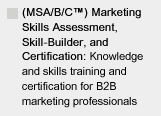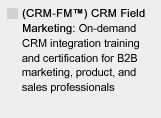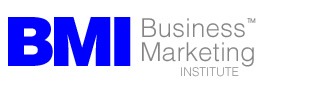MAKE SURE YOU CONTINUE TO RECEIVE EACH ISSUE OF TUESDAY MARKETING NOTES—CLICK HERE TO RENEW YOUR FREE SUBSCRIPTION
Quick Market Testing and Key Marketing Measurements Using Pay-Per-Click Search and Fractional Print Advertising
by Eric Gagnon
Print direct mail is a powerful means for market-testing sales copy, promotions, pricing, and other critical aspects of your marketing program. Online pay-per-click (PPC) advertising programs, such as Google AdWords, can also be used as a powerful, effective, and very fast method for testing many aspects of your marketing program's sales copy, benefits, headlines, pricing and other key product positioning features, for all other marketing programs, not just online advertising.
Online Pay-Per-Click Testing
Online text search pay-per-click (PPC) advertising programs, such as Google AdWords, are naturally suited to market testing. The main advantage of using PPC advertising is speed of result: You can test an infinite combination of keywords, text ads, headlines, and landing page promotions, and you can see the final result faster, and with more precise measurability, compared to any other form of market testing or advertising.
The big disadvantage to PPC advertising is that, for many specialized B2B products, the volume isn’t there (yet) to generate the sales response to justify spending a lot of time running PPC ad programs. Also, PPC advertising is more suited for selling some types of products, such as IT hardware and software, than others, since computer-bound IT buyers may be far more likely to use Google and other search engines daily to find products of interest, compared to prospects in other fields.
It could be that a lot of the folks in your market aren’t sitting in front of their computers all day searching the Internet, like IT people. If this is true for your market, then you may not generate a high enough volume of traffic and sales response to make PPC advertising a viable part of your marketing program.
So, your success in using online pay-per-click (PPC) advertising to market and sell your company’s (or client’s) product depends entirely on whether or not there are enough Internet users in your market who are searching for products like yours to justify the effort. You won’t know this unless you get out there and start running AdWords tests to see whether or not PPC advertising works for your company and this, once again, is why testing is important in your marketing program.
Using PPC for Quick Sales Copy Testing
However, even where the response volume may be low, I’m still very enthusiastic about using AdWords as a method for quickly testing the sales appeal of headlines, copy, and benefits for B2B products and services, and for using sales copy that tests well here in other, “offline” advertising programs in other marketing media, such as print advertising and direct mail.
Since there’s no reason why a headline that pulls well in an AdWords text ad can’t be just as compelling when used in a mailing piece, a printed display ad, or any other offline deliverable, keyword search advertising is an ideal tool for dialing in the best headlines and major sales benefits you can use in other types of marketing media. For this reason, you should strongly consider using Google AdWords programs as small test beds for trying out new sales copy ideas, headlines, pricing options, and promotions.
You can run very useful tests of sales copy, new positioning appeals, pricing, and promotions by linking keywords in your PPC program to a free information premium (your actionable offer), such as a report or white paper, accessible at individual landing pages that are set up to track the number of page accesses and downloads of the free information premium being offered.
While you may not receive a large sales response from PPC and other Net-based marketing programs for your company’s specialized business-to-business product, using PPC as a means to get fast feedback on tests of basic sales copy benefit appeals makes it an excellent testing feature. It’s also good to start using this new medium now, because there’s no doubt that online and PPC advertising will be playing a larger and more important role in your marketing program.
Using Print Advertising for Market Testing
Can print advertising be used in the same fashion to test copy, promotions, etc.? Yes, but only if you understand its limitations. As a technique for testing sales copy and positioning, print advertising is generally a less attractive option compared to using direct mail testing. First, print advertising is generally less effective at generating measurable sales response compared to other marketing methods. Second, trade publication print advertising schedules require longer lead times than direct mail, which means you’ll wait longer to get actionable test results for your marketing program. Third, because some readers won’t usually remember where they saw your ad, it is more difficult to accurately track and measure response from advertising.
Despite these drawbacks, print advertising can play a valuable role in your marketing program, and can be used not only for market testing purposes, but can also be used for testing ad placements to assess the viability of adding print advertising to your marketing plan.
Which ad page size to use? One of the biggest myths in marketing is that you have to run full page ads to get the best results from an advertising program. If you master the techniques of making smaller ads “act big,” (we covered some of these techniques in TMN 5 at this link: http://www.businessmarketinginstitute.com/tmn102505.html), you don’t need to buy full pages. You can run half, quarter, or even smaller ad page sizes if you are using a strong, actionable, measurable offer to drive readers from the print ad to take action by going to your Web site or calling your company.
Techniques for testing print advertising: The ideal testing method for running print advertising is the “A/B split,” where two different ad layouts are run in alternate printed copies of the same issue of a publication. Unfortunately, A/B split testing is not available for many trade publications. As an alternative, you can run two different fractional ad layouts in the same publication, or (better yet) a different layout of the ad in two separate issues to test print ad layouts in the publication. Tag each ad with its own unique URL and log the responses to your actionable offer. Not the cleanest testing technique, but it’s the best way to determine if print advertising works for your company’s marketing program and, if so, which copy approaches work best.
Calculating ROI on Your Market Tests: Right and Wrong Approaches
“Measurability” is the hot topic in marketing these days, and seems to be focused almost exclusively on attempting to measure return on investment (ROI) for every marketing activity. ROI works well for calculating the return from static, dumb, easily measurable things like upgrading to a new piece of equipment, but it doesn’t work so well with dynamic processes like marketing.
ROI only measures the immediate, short-term profit or loss of the marketing activity, and completely misses the larger, measurable benefits that this marketing activity may have produced over longer time periods. Using ROI to measure a marketing program is like taking a picture of the Grand Canyon with a telescope: You’ll get a good picture of the rock on the far canyon wall, but you’ll never see everything else you’ve missed that’s important. Fortunately, there are two better measures for calculating profit or loss on marketing activities: Cost-per-lead/sale, and lifetime value of a customer.
Cost-per-lead and cost-per-sale: Cost-per-lead and cost-per-sale calculations tell you instantly whether it’s more expensive to generate responses and sales using one form of marketing media than another, which is (or should be) a key influence in guiding your decision on where you should be spending your marketing budget.
Calculate your cost-per-lead from a market test by dividing the total cost of the mailing, ad, or other marketing activity by the number of responses received, and compare this cost against other marketing methods you’re currently using, such as print advertising or trade shows. Once you’ve calculated your cost-per-lead, determine your cost-per-sale by dividing the cost of the marketing activity by the final number of buyers who converted from prospects to customers from the marketing activity.
Cost-per-lead and cost-per-sale calculations underscore the importance of running marketing programs that can be measured. But you can never truly measure anything in your marketing program unless your ads, mailings, and other marketing activities motivate interested readers to contact your company, call a distributor, download a white paper, or take any other step you want them to take in your marketing program. And measurability begins with clear presentation of your product’s most unique and compelling sales benefits.
Calculating the lifetime value of a customer: As we all know, most companies in B2B do not make one-shot sales to their customers, but instead make many repeat sales in volume to a customer over a multi-year period. Because of this, a better way to measure the response of any marketing activity is to first calculate the lifetime value of a customer, and then compare the cost of each marketing activity, and prospects converted to customers from this marketing activity, against this lifetime customer value.
The lifetime value of a customer can be calculated by averaging the total sales generated by the average customer during their business relationship with your company. The length of this relationship is your best estimate of the average length of time your average customer buys from your company. If this time period cannot be easily estimated, you can use a set period of time, such as three years.
Next, multiply this average by your company’s profit margin (in percent). The resulting dollar figure is your average lifetime dollar profit from a customer. If you can acquire each new customer at a cost that is less than this amount, then your marketing program is generating profitable sales response, on a gross basis.
Both of these calculations are better ways to measure the response of marketing programs than ROI calculations, which focus only on the quick-hit return of a single mailing, ad placement, or other marketing activity. The danger of using ROI is that it causes you to rule out many marketing opportunities that, while generating lower or negative returns when measured using ROI alone, are still profitable when you consider the fact that once you acquire a customer from a marketing activity, you are also acquiring an ongoing, multi-year income stream from this customer’s long-term business with your company. ROI misses this critical aspect entirely, and could cause you to drop out of many lucrative marketing opportunities, just because the one-shot marketing activity, while generating new customers, didn’t generate a sufficient return by itself.
Using cost-per-lead and cost-per-sale is a better way to compare the response of one marketing effort to another in the short term, and measuring the cost of your sales response from a marketing activity to the lifetime value of your customer provides you with a clearer and more realistic view of your marketing program.
Eric Gagnon (eric@realmarkets.net), a director with the Business Marketing Institute, is author of The Marketing Manager’s Handbook and The CRM Field Marketing Handbook, and president of GAA ( http://www.realmarkets.net ), a marketing, sales turnaround, and product development consulting firm.







